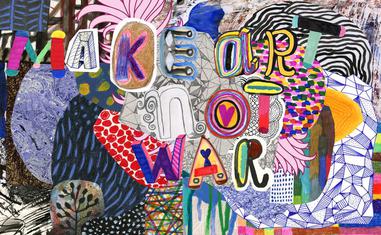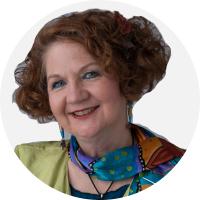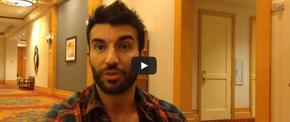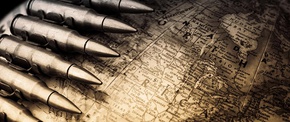The views expressed in our content reflect individual perspectives and do not represent the authoritative views of the Baha'i Faith.
As a creative person, since I became a Baha’i at 19 in the early 1970s, I have yearned to express my love for the Faith and its teachings through artistic expression.
Over the years I’ve utilized the arts in a variety of ways including poetry, prose, theatre, dance, visual media, film, glass fusion, book production, and jewelry making. My husband and I created two feature-length documentary films — Luminous Journey: Abdu’l-Baha in America, 1912, and Abdu’l-Baha in France — something I could not have imagined doing years ago. These artistic activities have brought a great deal of meaning into our lives, particularly when they have involved collaboration and community support.
Profoundly moved by studies related to the intersection of art and religion, I even pursued my doctoral degree in the subject. Some other Baha’is I know focus on scholarship on the arts, as well as on painting, music, architecture, calligraphy, and other modes of creative expression. All of this means that I’ve attended and sometimes organized various arts events, conferences, seminars, courses, retreats, holy day celebrations, writing groups, and so forth, meeting with many like-minded people both inside and outside of the Baha’i community. My husband and I currently serve on our town’s art commission under the city council, and I teach at a college dedicated to the arts.
RELATED: Reflections on the Healing Power of Poetry
Pursuing and engendering the creative path has provided ample fulfillment (as well as numerous tribulations), but not until recently have I felt the world waking up to the power of the arts – as this single phrase in a letter from the Universal House of Justice, the democratically-elected administrative body of the world’s Baha’is, suggests:
… increasing attention needs to be given to other processes that seek to enhance the life of a community — for example, by improving public health, protecting the environment, or drawing more effectively on the power of the arts.
We all know that public health and the environment are major concerns for humankind at this critical stage of global evolution. Including the power of the arts as a major focus is an exciting and confirming sign of how vital the arts are to the civilization we are building. For me, it has already created a sea-change in consciousness — one some of us have anticipated for decades.
Soon after the Universal House of Justice directed Baha’is to focus our attention on the arts, I taught an online course on the arts through the Wilmette Institute. The course normally attracts ten to fifteen learners, but this time more than 50 people took part from seven different countries, many of whom had previously felt isolated as artists. They were surprised at the plethora of sources we drew from — the Baha’i writings, articles, books, podcasts, videos, films, and the like — and they were surprised, too, that a community of creatives existed around the world who could exchange creative work, ideas, and aspirations on the course platform.
The life-giving aspects of that course astonished all of us. One learner, in fact, said she signed up for the course as a direct response to the House of Justice’s message. For me, this was a profound indication of a growing awareness on the part of artists, art enthusiasts, and community members interested in learning more about how to utilize the arts.
When we can experience the joy of creative expression in its diverse forms and by diverse individuals, we gain a different perception of unity. The recent Association for Baha’i Studies conference in Atlanta, Georgia, attended by 1800 people, was infused with the arts and enhanced by a prevalence of racial diversity and unity. Because of the recent guidance from the House of Justice, I felt that gathering heightened awareness of the power of the arts for everyone who attended.
Music, dance, visual art, film, and other aspects of creativity were very much part of the recent Parliament of the World’s Religions conference in Chicago, contributing to an atmosphere of inclusion, mutual respect, hope, and coherence.
This emphasis on the spiritual power of the artistic imagination isn’t new to Baha’is, though. Many references to the importance of the arts can be found throughout the Baha’i writings, such as these statements from Baha’u’llah’s writings:
- Arts, crafts and sciences uplift the world of being, and are conducive to its exaltation.
- … the true worth of artists and craftsmen should be appreciated, for they advance the affairs of mankind.
- The people of Baha should not deny any soul the reward due to him, should treat craftsmen with deference, and unlike the people aforetime, should not defile their tongues with abuse. In this Day the sun of craftsmanship shineth above the horizon of the occident and the river of arts is flowing out of the sea of that region. One must speak with fairness and appreciate such bounty ….
Like religion, the arts have an experiential dimension that takes us beyond the capacities of the mind and have the capacity to move the soul. We can study art or religion and learn a great deal about them, but not experience transcendental moments or the creative process. With both — the study and the uplifting practice or experience of art or religion — a new way of being in the world opens to us.
The arts offer us a unique way to experience the creative process, which the Baha’i teachings ask us to see as a form of worship. Whether we engage with the creativity as rank beginners or as skilled professionals, we are changed through making art. As humans with the capacity to reflect some of the attributes of God, we can partake of the energy of our Creator. In Lady Blomfield’s book The Chosen Highway, Abdu’l-Baha, the son and successor of Baha’u’llah, is quoted as saying:
All Art is a gift of the Holy Spirit. When this light shines through the mind of a musician, it manifests itself in beautiful harmonies. Again, shining through the mind of a poet, it is seen in fine poetry and poetic prose. When the light of the Sun of Truth inspires the mind of a painter, he produces marvelous pictures. These gifts are fulfilling their highest purpose when showing forth the praise of God.
And to a specific artist, he wrote:
I rejoice to hear that thou takest pains with thine art, for in this wonderful new age, art is worship. The more thou strivest to perfect it, the closer wilt thou come to God. What bestowal could be greater than this, that one’s art should be even as the act of worshipping the Lord? That is to say, when thy fingers grasp the paint brush, it is as if thou wert at prayer in the Temple.
RELATED: Being Light – Even When Life Gets Heavy
Why is drawing on the power of the arts so critical at this juncture in human history? Perhaps it relates to the community-building process now taking place, which has the capacity to move us from an ethnocentric perspective to a global one. Artistic expression provides a means of helping us value and develop creative, transformative, and resilient attributes and appreciate humanity’s rich diversity. Addressing the time period in which we live, Abdu’l-Baha explained in his writings that:
The autumn hath gone by, and the reviving spring is here. All things are now made new. Arts and industries have been reborn, there are new discoveries in science, and there are new inventions; even the details of human affairs, such as dress and personal effects — even weapons — all these have likewise been renewed. The laws and procedures of every government have been revised. Renewal is the order of the day.
He also predicted that: “There will be a new art, a new architecture, fused of all the beauty of the past, but new,” and that “The stage will be the pulpit of the future.”
Coming into focus now, on a world stage, the future beckons us more brightly. Against the devastation of climate, environmental, and health crises and concerns, the creative spirit of humankind affirms new possibilities and solutions, reflecting its organic unity yet infinite diversity. Might it be that the power of the arts will surprise, delight, and maybe even transform us along the way?

















Comments
Sign in or create an account
Continue with Facebookor